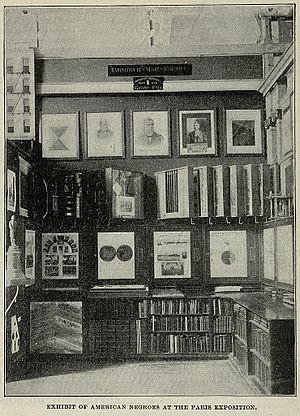The Exhibit of American Negroes facts for kids
The Exhibit of American Negroes was a special display at the 1900 World's Fair in Paris, France. It was part of the Palace of Social Economy. This exhibit was created by Daniel Alexander Payne Murray, Thomas J. Calloway, and W. E. B. Du Bois. Their main goal was to show the amazing progress and achievements of African Americans around the year 1900.
The exhibit featured many interesting items. It included a small statue of Frederick Douglass, a famous leader. There were also four books filled with nearly 400 patents created by African Americans. Patents are official documents that protect new inventions. The display also showed photos from several important schools like Fisk University and Tuskegee University. A special list of 1,400 books about African Americans was also part of the exhibit.
Two important studies by W. E. B. Du Bois were also shown. One was called "The Georgia Negro," which had 32 handmade charts. The other had about 30 charts showing facts about the African-American population. These were made by Du Bois's students. Most famously, the exhibit had about 500 photographs. These pictures showed African-American men and women, their homes, churches, businesses, and landscapes. Some of these photos were taken by Thomas E. Askew.
Contents
How the Exhibit Started
The idea for the exhibit came from Thomas Junius Calloway. He was an African-American lawyer and teacher. He sent letters to many African-American leaders across the United States. He asked for their help to create this special exhibit for the Paris World's Fair.
Calloway wrote that thousands of people would visit the fair. He believed a good exhibit showing the progress of African Americans would get attention. It would help people understand the great things African Americans could achieve.
Booker T. Washington, another important leader, spoke directly to President William McKinley. Just four months before the fair opened, the United States Congress gave $15,000 to fund the exhibit. Calloway then asked Du Bois and Daniel Murray to help gather all the materials.
What Photos Were Included?
W. E. B. Du Bois chose many photographs for the exhibit. He called them "typical Negro faces." These photos were meant to show the achievements of African Americans. He put together three large albums of pictures. The photographer's name was not shared at the exhibit.
Some photos were formal studio portraits. These are like professional photos taken in a studio. But there were also informal snapshots. These showed groups of people, children playing, people working, and families on outings. There were also pictures of houses, businesses, and the inside of homes.
Where Was the Exhibit?
The Exhibit of American Negroes was not inside the main United States building at the fair. Instead, it was in the Palace of Social Economy and Congresses. This was a shared space with other displays. These included maps of U.S. resources, models of New York City tenement buildings, and information about labor unions and libraries.
The exhibit was open from April to November 1900. More than 50 million people visited the World's Fair during that time.
How Was the Exhibit Received?
Most major American newspapers did not write about the Negro Exhibit. Even the U.S. commissioner-general did not mention it in his main article about the fair. However, the Negro Exhibit took up a quarter of the total space given to the U.S. in the Palace of Social Economy. Black newspapers, like The Colored American, wrote a lot about the project.
Where Is It Now?
Today, the Exhibit of American Negroes is kept safe at the Library of Congress.


